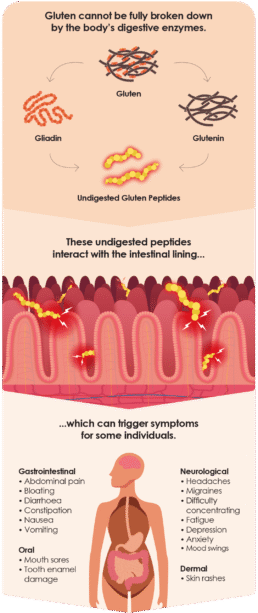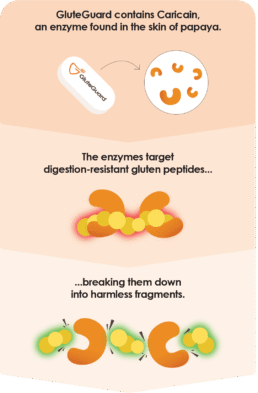What is gluten?
Gluten is a protein found in wheat, barley, and rye, including varieties and derivative species of these grains, such as spelt, triticale, and durum1.
Gluten isn’t a single protein, but rather a combination of two main types of proteins: gliadin and glutenin1.
When combined with water, these proteins bond together to form the stretchy, elastic network that gives bread, pasta, and other baked goods their characteristic texture2.
Gluten digestion
When gluten is consumed, the body’s digestive enzymes are unable to fully break down gliadin and glutenin, leaving behind partially digested proteins called peptides1.
In the small intestine, these undigested peptides can interact with cells in the intestinal lining or cross through the gut barrier, causing problems for susceptible individuals3.
Who is gluten a problem for?
For most people, these undigested gluten peptides continue through the digestive system without issue.
However, in individuals with gluten-related disorders, they can trigger a variety of intestinal or extraintestinal symptoms when they interact with the lining of the small intestine4.
In coeliac disease, these peptides also trigger immune activation and inflammation that lead to intestinal damage1.

Treatment for gluten-related disorders
A gluten free diet remains the only treatment available for gluten-related disorders such as coeliac disease, dermatitis herpetiformis, and non-coeliac wheat/gluten sensitivity.
However, even with careful dietary adherence, accidental gluten ingestion is common – particularly when eating outside the home, where meal preparation is difficult to control5.
How GluteGuard helps
GluteGuard supports the maintenance of a gluten free diet by protecting against symptoms of accidental gluten ingestion6, 7.
It contains Caricain, a unique enzyme found in the skin of unripe papaya, which is able to break down the digestion-resistant gluten peptides known to trigger symptoms in people with gluten-related disorders8.
Taken before a meal as a pre-emptive measure, GluteGuard helps to break these peptides into smaller, harmless fragments before they can interact with the intestinal lining and trigger symptoms.
In this way, GluteGuard offers protection against symptoms of accidental gluten ingestion and peace of mind when meals are prepared by others.

What is gluten?
Gluten is a protein found in wheat, barley, and rye, including varieties and derivative species of these grains, such as spelt, triticale, and durum1.
Gluten isn’t a single protein, but rather a combination of two main types of proteins: gliadin and glutenin1.
When combined with water, these proteins bond together to form the stretchy, elastic network that gives bread, pasta, and other baked goods their characteristic texture2.
Gluten digestion
When gluten is consumed, the body’s digestive enzymes are unable to fully break down gliadin and glutenin, leaving behind partially digested proteins called peptides1.
In the small intestine, these undigested peptides can interact with cells in the intestinal lining or cross through the gut barrier, causing problems for susceptible individuals3.
Who is gluten a problem for?
For most people, these undigested gluten peptides continue through the digestive system without issue.
However, in individuals with gluten-related disorders, they can trigger a variety of intestinal or extraintestinal symptoms when they interact with the lining of the small intestine4.
In coeliac disease, these peptides also trigger immune activation and inflammation that lead to intestinal damage1.

Treatment for gluten-related disorders
A gluten free diet remains the only treatment available for gluten-related disorders such as coeliac disease, dermatitis herpetiformis, and non-coeliac wheat/gluten sensitivity.
However, even with careful dietary adherence, accidental gluten ingestion is common – particularly when eating outside the home, where meal preparation is difficult to control5.
How GluteGuard helps
GluteGuard supports the maintenance of a gluten free diet by protecting against symptoms of accidental gluten ingestion6, 7.
It contains Caricain, a unique enzyme found in the skin of unripe papaya, which is able to break down the digestion-resistant gluten peptides known to trigger symptoms in people with gluten-related disorders8.
Taken before a meal as a pre-emptive measure, GluteGuard helps to break these peptides into smaller, harmless fragments before they can interact with the intestinal lining and trigger symptoms.
In this way, GluteGuard offers protection against symptoms of accidental gluten ingestion and peace of mind when meals are prepared by others.
References
1. Biesiekierski, JR. What is gluten?. J Gastroenterol Hepatol, 2017;32:78–81.
2. Aljada B, Zohni A, El-Matary W. The gluten-free diet for celiac disease and beyond. Nutrients. 2021 Nov 9;13(11):3993.
3. Cebolla Á, Moreno MD, Coto L, et al. Gluten immunogenic peptides as standard for the evaluation of potential harmful prolamin content in food and human specimen. Nutrients. 2018 Dec 5;10(12):1927.
4. Sapone A, Bai JC, Ciacci C, et al. Spectrum of gluten-related disorders: consensus on new nomenclature and classification. BMC Med. 2012 Feb 7;10(1):13.
5. Silvester JA, Graff LA, Rigaux L, et al. Symptomatic suspected gluten exposure is common among patients with coeliac disease on a gluten-free diet. Aliment Pharmacol Ther. 2016 Sep;44(6):612-619.
6. Cornell HJ, Czyzewska A, Macrae FA, et al. The effect of enzyme supplementation on symptoms and duodenal histology in celiac patients. Int J Celiac Dis. 2016;4:40-47.
7. Żebrowska A, Cornell HJ, Macrae FA, et al. The effect of enzyme therapy on skin symptoms and immune responses in patients with dermatitis herpetiformis. Int J Celiac Dis. 2014;2(2):58-63.
8. Tanner GJ. Relative rates of gluten digestion by nine commercial dietary digestive supplements. Front Nutr. 2021 Dec 7;8:784850.

